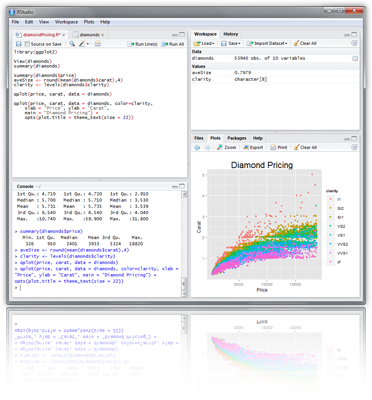Author: Thomas Girke
Last update: 15 February, 2016
Alternative formats of this tutorial:
.Rmd HTML,
.Rmd Source,
.R Source,
PDF Slides
Overview
What is R?
R is a powerful statistical environment and
programming language for the analysis and visualization of data. The
associated Bioconductor and CRAN package
repositories provide many additional R packages for statistical data analysis
for a wide array of research areas. The R software is free and runs on all
common operating systems.
Why Using R?
- Complete statistical environment and programming language
- Efficient functions and data structures for data analysis
- Powerful graphics
- Access to fast growing number of analysis packages
- Most widely used language in bioinformatics
- Is standard for data mining and biostatistical analysis
- Technical advantages: free, open-source, available for all OSs
Books and Documentation
- simpleR - Using R for Introductory Statistics (John Verzani, 2004) \href{http://cran.r-project.org/doc/contrib/Verzani-SimpleR.pdf}}
- Bioinformatics and Computational Biology Solutions Using R and Bioconductor (Gentleman et al., 2005) \href{http://www.bioconductor.org/help/publications/books/bioinformatics-and-computational-biology-solutions/}}
- More on this see “Finding Help” section in UCR Manual \href{http://manuals.bioinformatics.ucr.edu/home/R_BioCondManual#TOC-Finding-Help}}
R Working Environments
Working environments (IDEs) for R
 R Projects and Interfaces
R Projects and Interfaces
Some R working environments with support for syntax highlighting and utilities to send code
to the R console:
Example: RStudio
New integrated development environment (IDE) for R. Highly functional for both beginners and
advanced.
 RStudio IDE
RStudio IDE
Some userful shortcuts: Ctrl+Enter (send code), Ctrl+Shift+C (comment/uncomment), Ctrl+1/2 (switch window focus)
Example: Vim-R-Tmux
Terminal-based Working Environment for R: Vim-R-Tmux
 Vim-R-Tmux IDE for R
Vim-R-Tmux IDE for R